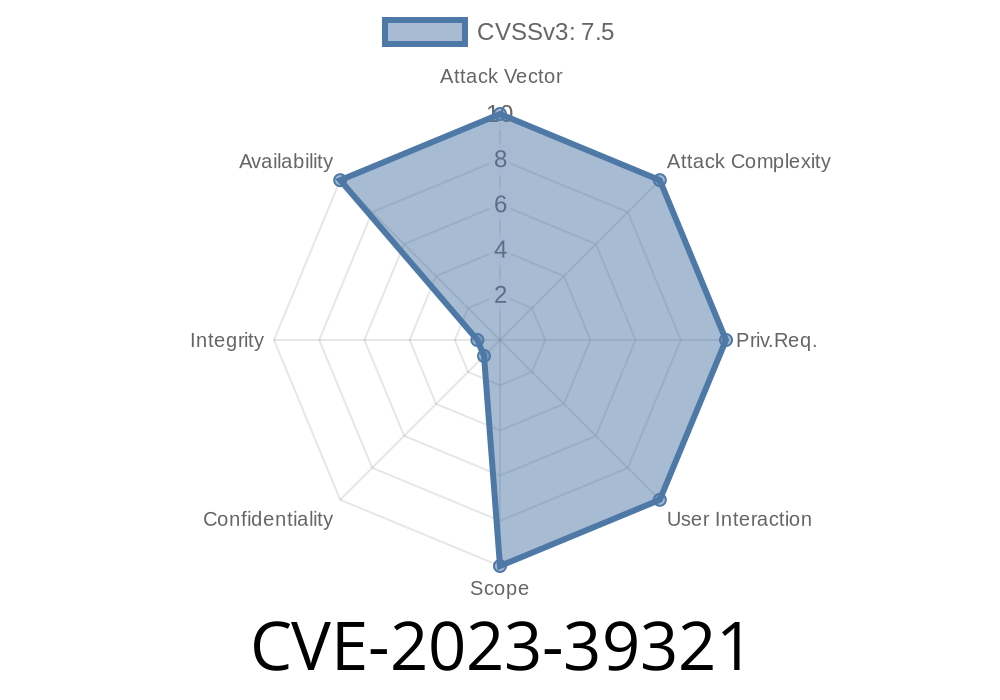In this blog post, we are going to discuss a newly discovered vulnerability, CVE-2023-39321, that affects the processing of incomplete post-handshake messages in the QUIC protocol. This can lead to a sudden termination or panic in the affected system. We'll look at an example of a vulnerable code snippet, and then provide analysis on how the exploit works, potential consequences, and possible mitigation strategies.
For a more detailed understanding of the QUIC protocol, please refer to the official IETF QUIC Transport Protocol documentation.
Code Snippet
The following is a code snippet that demonstrates the vulnerability when processing an incomplete post-handshake message for a QUIC connection:
func processPostHandshakeMessage(msg []byte, conn *quic.Connection) bool {
dataSize := binary.BigEndian.Uint32(msg[:4])
if len(msg) < int(dataSize) + 4 {
return false
}
data := msg[4:4 + dataSize]
// Process the data.
}
This snippet simply reads the expected dataSize from the message, checks if the length of the received message is smaller than the expected dataSize, and, if it is not, processes the data. If an attacker sends an incomplete message, where the dataSize is greater than the actual received data length, this code will not handle it correctly and could cause a panic in the application.
Exploit Details
The vulnerability lies in not properly handling incomplete post-handshake messages received from a QUIC connection during processing. An attacker can exploit this by sending a carefully crafted message, intentionally providing a dataSize that exceeds the actual data length.
For example, consider a message with dataSize set to xFFFF (a large value), while the actual data length is only 4 bytes:
+--------+--------+--------+--------+--------+
| xFF | xFF | xFF | xFF | data |
+--------+--------+--------+--------+--------+
In this case, the processing function would expect to read xFFFF bytes of data after the dataSize but would instead encounter the end of the message. As a result, the check for the sufficient data length would fail, and the system may experience a panic, potentially leading to unhandled errors or crashes.
Consequences
An attacker who successfully exploits this vulnerability can cause the targeted application or system to crash, potentially leading to connection disruptions and denial of service (DoS) conditions. This could negatively impact the target's availability and performance, potentially affecting the end-user experience or business operations.
Mitigation Strategies
To mitigate this vulnerability, developers should ensure that they are properly validating the integrity of post-handshake messages before processing them. This includes checking whether the data size specified in the message is within acceptable boundaries and verifying that the actual data length matches the expected data size. The updated mitigation code snippet should look like this:
func processPostHandshakeMessage(msg []byte, conn *quic.Connection) bool {
if len(msg) < 4 {
return false
}
dataSize := binary.BigEndian.Uint32(msg[:4])
if len(msg) < int(dataSize) + 4 {
return false
}
data := msg[4:4 + dataSize]
// Process the data.
}
By adding an initial length check before reading the dataSize, developers can ensure that they only process messages with valid data sizes. Furthermore, developers should consider implementing more comprehensive validation logic and error handling for their QUIC protocol implementations to minimize the risk of similar vulnerabilities in the future.
In conclusion, CVE-2023-39321 demonstrates how improperly handling incomplete post-handshake messages during QUIC connection processing can leave systems vulnerable to targeted denial-of-service attacks. To help prevent security incidents, developers should take steps to improve their validation and error-handling processes for QUIC connections and follow security best practices when implementing and deploying new protocols.
Timeline
Published on: 09/08/2023 17:15:28 UTC
Last modified on: 11/25/2023 11:15:17 UTC
